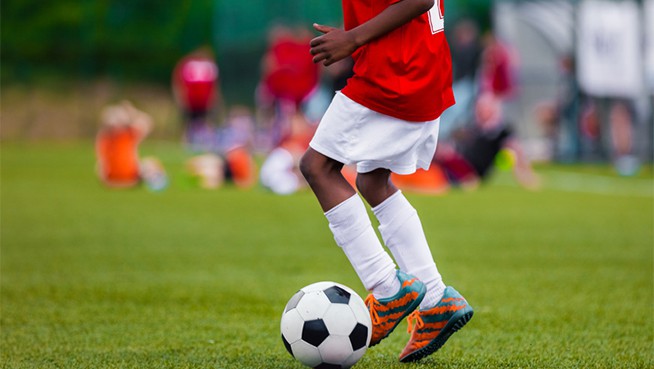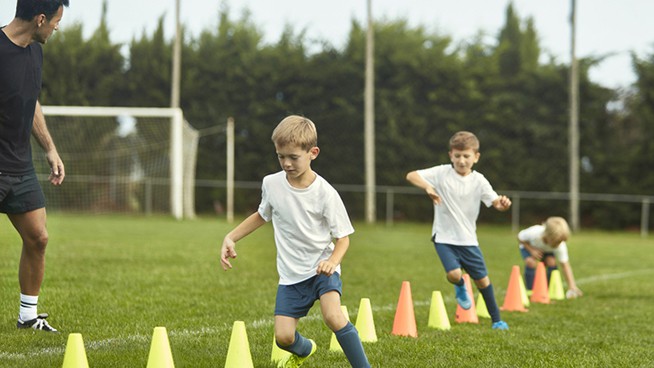My Favorite Speed Drills for Soccer Players
“What is the answer to speed development?”
Soccer players, soccer parents and soccer coaches, alike, often ponder this question.
In one corner, you have the coach who says running nothing but sprints is the answer.
In another, a coach who says strength is the real key.
Then there’s the parent who believes shuffling feet through a speed ladder is in fact the pinnacle of speed development.
Who’s right? Who’s wrong?
Or is the real answer somewhere in the middle ground?
I believe developing speed requires a multi-faceted approach. To say that just running sprints, or just getting stronger, or just doing “speed ladders” is the best option for your athlete is, in my opinion, a disservice to your athletes.
Soccer players deserve to be trained in a way that optimizes their movement and coordination, enhances their strength, increases their power, and hones their sprint mechanics. Filling all of these buckets in the right proportions will help develop lightning-fast players.
This much I know: the evolution of soccer calls for smarter speed trainers. Players are becoming faster, more powerful, and more explosive, and games are often decided on actions that involve beastly speed, such as a counterattack, a transition play, a diagonal run, a cross and finish, or a one-on-one dash past a defender to whip a shot on goal.
Speed wins soccer games.
Additionally, players are becoming more susceptible to sprinting-related injuries due to ill-conceived or ill-executed training programs. Hamstring strains, especially, run rampant in high-speed soccer efforts. Soccer athletes need speed training that strengthens the connective tissue and muscles and improves mobility and posture.
So how do you develop speed to improve performance while also reducing your chance of injury?
Instead of making this an article with only “sprint” drills or “strength” drills, I want to provide you with a sample template you can use for your training week.
Mobility for Speed
Your players need to be supple enough to drive their hips during acceleration and at top speed.
Too often, young athletes lack the mobility in their hip flexors to be able to accelerate and run properly. This causes them to place too much load on their knees and can cause injury (e.g., patellar pain). Expounding further, if their ankles lack mobility and fail to move into dorsiflexion, they will not be running on the balls of their feet to produce force. This “forward dominant sprinting” is rarely fast and puts excess force on the knees.
Here are a few of my favorite warm-up mobility drills I use with my soccer players prior to a speed session:
Knee Tuck
Plank Cross Crawl Inchworm
Ankle Mobility
Posture for Speed
Postural drills are overlooked in speed training, but they play an important part in helping athletes discover efficient sprinting mechanics. Starting with acceleration, players need to learn how to load the glutes and hamstrings and the balls of their feet while keeping a forward posture (shoulders over hips, chest projected up) to propel them forward. I’m a fan of this Kneeling Acceleration Lean drill from speed development coach Lee Taft:
Kneeling Acceleration Leans
Taking the conversation from acceleration posture to maximal speed posture, the hip flexors must be able to perform the primary muscle action during the swing phase, without rounding or compensation of the spine. This simple Knee Tuck Hold drill will get your players in proper position to run at maximal speed (knee lined up with hip flexor, neutral spine, chest and shoulders stacked on top of hips, eyes looking straight ahead):
Hanging Knee Tuck Hold
Sprint Drills (a.k.a., Run Fast Drills)
Now the fun part: time to run fast.
To build speed, players need to sprint often. Small-sided games in practice often fail to allow players to sprint linearly for long enough to reach their top speed, so we need to ensure they are exposing their neuromuscular system to the unique rigors of maximal velocity.
However, we must also keep in mind that soccer is a game of starts and stops.
For soccer players, doing sprint drills with various starts and stops is a great way to prepare them for the spontaneous actions of the game. Keep in mind when doing sprint drills to allow players adequate rest. Using a stopwatch to eyeball how quickly they’re completing a sprint drill can help you find the right amount of rest for each athlete (hint: if they’re slowing way down, they need more rest). I generally find I give my athletes 60 seconds rest (or slightly beyond that) between sprint efforts.
Sprinting with maximal speed while providing players with full recovery is where the magic happens here, and can make or break speed development. Even if you cannot currently invest in an electronic timing system, regularly hand-timing them can help increase their intent.
Incorporating resistance training is another aspect of speed programming for consideration:
Sled Sprints
Lateral Sled Sprints
Power Drills
Power drills are a great way to optimize fast-twitch muscle fiber recruitment and get athletes to produce more force. These drills should be done in conjunction with a speed program (2-3 times a week) so athletes continue to become more explosive.
Here are a few of my favorite power drills to incorporate into your speed programming:
Fast Contact Broad Jump
Vertical Jump
Soccer Training Program Template
To give you a more meticulous idea of how you can put this all together, here is a sample week template:
- Monday: Mobility + Movement + Full-Body Strength Day
- Tuesday: Posture + Power + Speed Day
- Wednesday: Mobility + Movement + Full-Body Strength Day
- Thursday: OFF
- Friday: Posture + Power + Speed Day
This is a great start to ensure players get enough recovery time between power and speed sessions, but also, they are able to reinforce mobility, movement and body strength on the other days.
I use a similar template with my athletes year-round, because after all, speed development doesn’t happen overnight.
Honing in on all of the components of speed consistently—from movement, to coordination, strength, power and mechanics—is magical. Once you give all of these love, your players will be exuberant and explosive on the pitch.
Photo Credit: matimix/iStock
READ MORE:
RECOMMENDED FOR YOU
MOST POPULAR
My Favorite Speed Drills for Soccer Players
“What is the answer to speed development?”
Soccer players, soccer parents and soccer coaches, alike, often ponder this question.
In one corner, you have the coach who says running nothing but sprints is the answer.
In another, a coach who says strength is the real key.
Then there’s the parent who believes shuffling feet through a speed ladder is in fact the pinnacle of speed development.
Who’s right? Who’s wrong?
Or is the real answer somewhere in the middle ground?
I believe developing speed requires a multi-faceted approach. To say that just running sprints, or just getting stronger, or just doing “speed ladders” is the best option for your athlete is, in my opinion, a disservice to your athletes.
Soccer players deserve to be trained in a way that optimizes their movement and coordination, enhances their strength, increases their power, and hones their sprint mechanics. Filling all of these buckets in the right proportions will help develop lightning-fast players.
This much I know: the evolution of soccer calls for smarter speed trainers. Players are becoming faster, more powerful, and more explosive, and games are often decided on actions that involve beastly speed, such as a counterattack, a transition play, a diagonal run, a cross and finish, or a one-on-one dash past a defender to whip a shot on goal.
Speed wins soccer games.
Additionally, players are becoming more susceptible to sprinting-related injuries due to ill-conceived or ill-executed training programs. Hamstring strains, especially, run rampant in high-speed soccer efforts. Soccer athletes need speed training that strengthens the connective tissue and muscles and improves mobility and posture.
So how do you develop speed to improve performance while also reducing your chance of injury?
Instead of making this an article with only “sprint” drills or “strength” drills, I want to provide you with a sample template you can use for your training week.
Mobility for Speed
Your players need to be supple enough to drive their hips during acceleration and at top speed.
Too often, young athletes lack the mobility in their hip flexors to be able to accelerate and run properly. This causes them to place too much load on their knees and can cause injury (e.g., patellar pain). Expounding further, if their ankles lack mobility and fail to move into dorsiflexion, they will not be running on the balls of their feet to produce force. This “forward dominant sprinting” is rarely fast and puts excess force on the knees.
Here are a few of my favorite warm-up mobility drills I use with my soccer players prior to a speed session:
Knee Tuck
Plank Cross Crawl Inchworm
Ankle Mobility
Posture for Speed
Postural drills are overlooked in speed training, but they play an important part in helping athletes discover efficient sprinting mechanics. Starting with acceleration, players need to learn how to load the glutes and hamstrings and the balls of their feet while keeping a forward posture (shoulders over hips, chest projected up) to propel them forward. I’m a fan of this Kneeling Acceleration Lean drill from speed development coach Lee Taft:
Kneeling Acceleration Leans
Taking the conversation from acceleration posture to maximal speed posture, the hip flexors must be able to perform the primary muscle action during the swing phase, without rounding or compensation of the spine. This simple Knee Tuck Hold drill will get your players in proper position to run at maximal speed (knee lined up with hip flexor, neutral spine, chest and shoulders stacked on top of hips, eyes looking straight ahead):
Hanging Knee Tuck Hold
Sprint Drills (a.k.a., Run Fast Drills)
Now the fun part: time to run fast.
To build speed, players need to sprint often. Small-sided games in practice often fail to allow players to sprint linearly for long enough to reach their top speed, so we need to ensure they are exposing their neuromuscular system to the unique rigors of maximal velocity.
However, we must also keep in mind that soccer is a game of starts and stops.
For soccer players, doing sprint drills with various starts and stops is a great way to prepare them for the spontaneous actions of the game. Keep in mind when doing sprint drills to allow players adequate rest. Using a stopwatch to eyeball how quickly they’re completing a sprint drill can help you find the right amount of rest for each athlete (hint: if they’re slowing way down, they need more rest). I generally find I give my athletes 60 seconds rest (or slightly beyond that) between sprint efforts.
Sprinting with maximal speed while providing players with full recovery is where the magic happens here, and can make or break speed development. Even if you cannot currently invest in an electronic timing system, regularly hand-timing them can help increase their intent.
Incorporating resistance training is another aspect of speed programming for consideration:
Sled Sprints
Lateral Sled Sprints
Power Drills
Power drills are a great way to optimize fast-twitch muscle fiber recruitment and get athletes to produce more force. These drills should be done in conjunction with a speed program (2-3 times a week) so athletes continue to become more explosive.
Here are a few of my favorite power drills to incorporate into your speed programming:
Fast Contact Broad Jump
Vertical Jump
Soccer Training Program Template
To give you a more meticulous idea of how you can put this all together, here is a sample week template:
- Monday: Mobility + Movement + Full-Body Strength Day
- Tuesday: Posture + Power + Speed Day
- Wednesday: Mobility + Movement + Full-Body Strength Day
- Thursday: OFF
- Friday: Posture + Power + Speed Day
This is a great start to ensure players get enough recovery time between power and speed sessions, but also, they are able to reinforce mobility, movement and body strength on the other days.
I use a similar template with my athletes year-round, because after all, speed development doesn’t happen overnight.
Honing in on all of the components of speed consistently—from movement, to coordination, strength, power and mechanics—is magical. Once you give all of these love, your players will be exuberant and explosive on the pitch.
Photo Credit: matimix/iStock
READ MORE:










